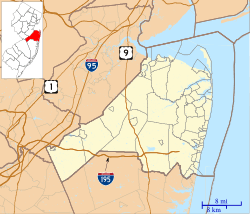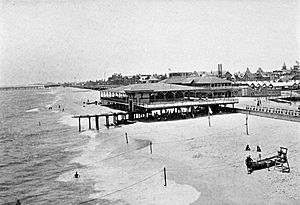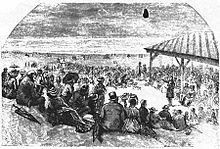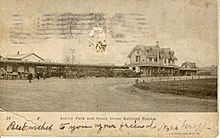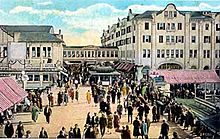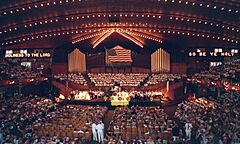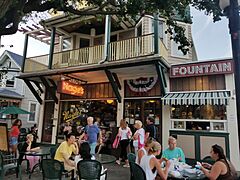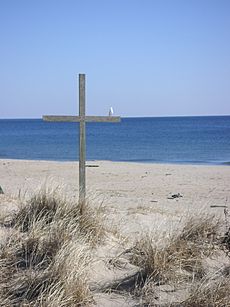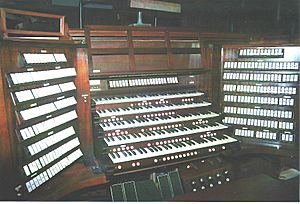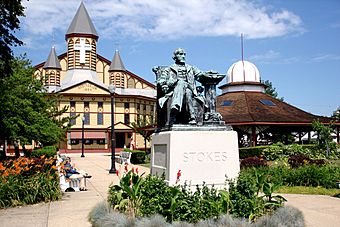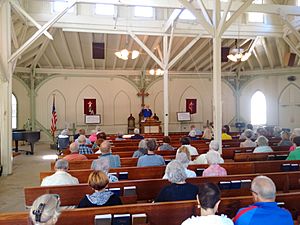Ocean Grove, New Jersey facts for kids
Quick facts for kids
Ocean Grove, New Jersey
|
|
|---|---|
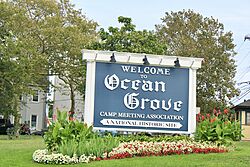
Ocean Grove welcome sign
|
|
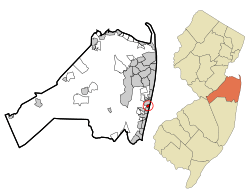
Location in Monmouth County circled and highlighted in red (left). Inset map: Location of Monmouth County in New Jersey highlighted in orange (right).
|
|
| Country | |
| State | |
| County | Monmouth |
| Township | Neptune |
| Area | |
| • Total | 0.42 sq mi (1.10 km2) |
| • Land | 0.37 sq mi (0.96 km2) |
| • Water | 0.05 sq mi (0.14 km2) 13.05% |
| Elevation | 16 ft (5 m) |
| Population
(2020)
|
|
| • Total | 3,057 |
| • Density | 8,239.9/sq mi (3,181.4/km2) |
| Time zone | UTC−05:00 (Eastern (EST)) |
| • Summer (DST) | UTC−04:00 (Eastern (EDT)) |
| ZIP Code |
07756
|
| Area code(s) | 732 |
| FIPS code | 34-54480 |
| GNIS feature ID | 02389609 |
Ocean Grove is a special community in New Jersey. It's part of Neptune Township in Monmouth County. About 3,057 people lived there in 2020.
Ocean Grove is right on the Jersey Shore by the Atlantic Ocean. It's located between Asbury Park to the north and Bradley Beach to the south. The town is famous for its beautiful Victorian architecture. It also has a huge building called the Great Auditorium. Many people say it's the most amazing wooden building in New Jersey.
Ocean Grove started in 1869. It was founded by a group of Methodist ministers. They wanted to create a summer camp meeting place by the sea. This was part of a movement where people gathered for religious meetings outdoors. By the early 1900s, it was known as the "Queen of Religious Resorts."
The land in Ocean Grove is still owned by the Ocean Grove Camp Meeting Association. They lease it to homeowners and businesses. Ocean Grove is the oldest continuously active camp meeting site in the United States.
Contents
Discovering Ocean Grove's Past
In July 1869, some Methodist ministers, including Reverend W. B. Osborn and Reverend Stokes, found a good spot on the New Jersey seashore. They decided to create a Christian community there. They named it "Ocean Grove." They chose this spot because it had no mosquitoes.
About twenty tents were set up that first summer. In 1870, the Ocean Grove Camp Meeting Association was officially formed. They bought the land. The land was divided into lots for homes and roads. People could lease these lots for 99 years. The Camp Meeting Association still owned the land.
Early residents had to follow strict rules. These rules included no alcohol, tobacco, cards, dancing, or reading novels. Nine wells were dug in 1870 for fresh water. The first well was called "Beersheba." It's still there today under an old gazebo.
Ocean Grove quickly became a popular place. Many people came from New York City and Philadelphia. Trains brought thousands of visitors after 1875. In 1877 alone, 710,000 train tickets were sold for the Ocean Grove-Asbury Park station.
A larger auditorium was built in 1880. But even that wasn't big enough.
The Great Auditorium's Construction
The current Great Auditorium was finished in 1894. It was designed to hold up to 10,000 people. Later, cushioned seats were added, which reduced the capacity to 6,250. This building is still the most important one in Ocean Grove. It's the center of summer events.
By the early 1900s, Ocean Grove was known as the "Queen of Religious Resorts." Millions of tourists and visitors came each summer. They enjoyed the Victorian charm and religious events. After World War I around 1920, there was less new construction. This helped Ocean Grove keep its old Victorian look.
Until 1981, Ocean Grove had its own unique laws. For example, it was illegal to have cars on the streets on Sundays. The beach was also closed on Sundays. This meant visitors often stayed for a week or more. They mostly came for the Camp Meeting programs.
Many famous people visited Ocean Grove. President Ulysses S. Grant made his last public appearance here. Other presidents like James Garfield and Teddy Roosevelt also spoke in town. Famous boxers and business leaders also vacationed in Ocean Grove.
In 1975, Ocean Grove became a State and National Historic District. It has the largest collection of Victorian buildings in the U.S. The Historical Society of Ocean Grove has a museum. They also offer walking tours of the old homes.
Ocean Grove's Recent Changes
From the 1960s to the 1980s, Ocean Grove faced some tough times. Many buildings became run-down. But in the 1990s, things started to get better. Property values went up, and old hotels were restored. Many new shops and cafes opened on Main Avenue.
In 2006, there were plans for a new hotel. This was on land where the old North End Hotel used to be. The old hotel was damaged by fire and torn down in 1980. However, these new plans caused debate. In 2008, the town's Planning Board said the plans didn't fit the town's overall vision. In 2019, the remaining buildings on that land were destroyed by fire.
In 2024, the Ocean Grove Camp Meeting Association (OGCMA) allowed Sunday beach access for a short time. This change happened after legal discussions with the state.
Ocean Grove's Location
Ocean Grove is in the southeastern part of Monmouth County, New Jersey. It's the only part of Neptune Township that touches the Atlantic Ocean. New Jersey Route 71 runs along the western edge of the community. This road goes north to Asbury Park and south to Bradley Beach. New Jersey Route 33 also ends at Route 71. Route 33 goes west to Freehold Borough, the county seat, and to Trenton, the state capital.
Ocean Grove covers about 0.425 square miles. Most of this is land, with a small part being water.
Ocean Grove's Population
| Historical population | |||
|---|---|---|---|
| Census | Pop. | %± | |
| 1880 | 620 | — | |
| 1890 | 2,754 | 344.2% | |
| 1990 | 4,818 | — | |
| 2000 | 4,256 | −11.7% | |
| 2010 | 3,342 | −21.5% | |
| 2020 | 3,057 | −8.5% | |
| Population sources: 1880-1890 1990–2010 2000 2010 2020 |
|||
Ocean Grove is a summer resort. This means many homes are empty in winter. So, the population numbers might not show how many people are there all year.
2010 Census Snapshot
In 2010, 3,342 people lived in Ocean Grove. There were 1,948 households. Most people (91.41%) were White. About 5.48% were Black or African American. About 4.34% of the population was Hispanic or Latino.
The average household had 1.64 people. The average family had 2.56 people. About 24.5% of the population was 65 years old or older. The median age was 52.7 years.
How Ocean Grove is Governed
William B. Osborn wanted to create a Christian seaside community. He chose the spot for Ocean Grove because it was wooded and had no mosquitoes. Ellwood H. Stokes and other Methodist ministers joined him. They bought a square mile of land by the Atlantic Ocean.
In 1870, the Ocean Grove Camp Meeting Association (OGCMA) was formed. This group of 26 trustees was given the power to buy land. They could also build and maintain services for the community. This included things like utilities and law enforcement.
Later, there were attempts to make Ocean Grove its own town. In 1920, it was briefly made a borough. But in 1921, a court ruled this was unconstitutional. So, Ocean Grove went back to being part of Neptune Township.
Even after 1921, the Camp Meeting Association still had some local powers. This changed in 1981. A newspaper delivery person sued to end a law that banned cars on Sundays. After this, the OGCMA stopped having its own police force.
The Camp Meeting Association still owns all the land in town. They lease it to homeowners and businesses for 99-year terms. Ocean Grove is still a "dry" town. This means selling alcohol is not allowed. The Camp Meeting also kept its beach closed on Sunday mornings until 2024.
The Great Auditorium: A Special Place
The Great Auditorium was built in 1894. It's mostly the same today. The front was extended in 1908 for a large organ. This wooden building sits on strong steel supports. It has many "barn door" entrances with colored glass. These panels can open for fresh air.
The Auditorium was first said to hold almost 10,000 people. Later, cushioned seats were added. This reduced the seating to 6,250 people. It's known as "the state's most wondrous wooden structure."
The building has amazing sound quality. This is because of its curved wooden ceiling. Famous conductor Leonard Bernstein compared it to Carnegie Hall. In the past, this allowed a speaker to be heard everywhere without microphones.
The Auditorium has a unique lighting system. Rows of bulbs hang from the ceiling. There's also a painted American flag with lights. These lights flash to make it look like the flag is waving. Old illuminated signs say "Holiness to the Lord." These signs reflect the religious focus of the camp meetings. A lighted cross was added in 1946 after World War II.
Around the hall are 114 tents. People live in these tents from May to September. This has been a tradition since 1869. Each tent has a small building with a kitchen and bathroom. These buildings also store the tents in winter. Many people want to rent these tents. There's a waiting list of about ten years.
The Auditorium's Giant Organ
The Auditorium's pipe organ is the 17th largest in the world. It was installed in 1908. Parts of it have been rebuilt and made bigger over time. Organist Gordon Turk and curator John Shaw have worked on it since the 1970s.
New parts were added in the 2000s. As of 2018, the organ has five keyboards. It has 202 sets of pipes and 12,200 total pipes. About 75% of the original pipes are still there.
Many famous organists have played here. These include Edwin Lemare and Virgil Fox. Gordon Turk and guest organists play free concerts. These happen on most Wednesday evenings and Saturday afternoons in July and August.
A popular piece played on the organ was "The Storm." It used the organ's sounds for thunder, lightning, and birds. Some people living nearby found it annoying because it was played so often.
Performances and Events
The Great Auditorium has hosted many famous performers. These include hymn writer Fanny Crosby and band leader John Philip Sousa. More recently, singers like Tony Bennett and Ray Charles have performed there.
The summer schedule also includes classical music concerts. These bring top musicians from Philadelphia and New York. Saturday nights used to feature popular entertainers. These included Johnny Mathis and the Beach Boys. Christian rock stars also performed. In 2017, the OGCMA decided to focus more on Christian programs. Now, mostly Christian, classical, and patriotic performances are held.
Since 1980, the Auditorium has held a yearly service. This service honors New Jersey police officers who died on duty. It includes an honor guard and bagpipes. High school choirs also sing. Police, soldiers, and the governor often attend.
High school graduation ceremonies are also held at the Auditorium in June.
Ocean Grove Camp Meeting Association
The Ocean Grove Camp Meeting Association (OGCMA) was founded in 1869. Its goal is to "provide opportunities for spiritual birth, growth, and renewal in a Christian seaside setting."
Tent City Tradition
From May to September each year, 114 tents are set up around the Great Auditorium. This is called "Tent City." It's a tradition that started in 1869. Each tent has a small building with a kitchen and bathroom. These buildings also store the tents in winter.
Many people want to rent these tents for the summer. There's a waiting list of over ten years. Rent costs between $4,000 and $6,000 for the summer. People who want to rent a tent are interviewed. You can't sublet tents. Dogs, cats, and barbecuing are not allowed. Tent residents don't have to be Methodist. But they must support the OGCMA's spiritual goals.
Summer Programs and Music
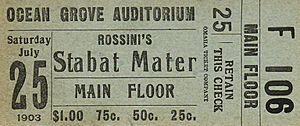
The Camp Meeting offers different worship programs in the summer. Sunday services are held in the Great Auditorium. Famous preachers like Billy Graham and Booker T. Washington have spoken there.
A volunteer choir leads the music. Professional singers also perform. Gordon Turk plays the Hope-Jones organ. Jason Tramm is the music director. Since 1955, an annual Choir Festival has been held. Thousands of church choir singers come to sing. This festival has been featured on TV and radio.
There's also a modern worship service called "Pavilion Praise." It's held at the beach's Boardwalk Pavilion on Sunday mornings. A Bible Hour is held every weekday morning. This takes place in the Bishop Janes Tabernacle, built in 1877. It's next to the Great Auditorium.
"Bridgefest" is a two-day event each year. It brings contemporary Christian music to young people and families. A local radio station promotes this event.
Hurricane Sandy's Impact
In 2012, Hurricane Sandy caused a lot of damage in Ocean Grove. More than half of the town's boardwalk was destroyed. The fishing pier was also badly damaged.
Ocean Grove was first denied money from the Federal Emergency Management Agency (FEMA). This was because the Camp Meeting Association is a nonprofit group. FEMA said the boardwalk was only for fun. The town formed a group called "Together" to help with recovery. This group included different community organizations.
Hurricane repairs were estimated to cost $3.5 million. The "Together" campaign raised $1.5 million. This included money for the boardwalk and the Great Auditorium roof. The Camp Meeting Association asked FEMA for funding three times. They were also denied funding after Hurricane Irene.
In 2013, different community groups worked together. They co-sponsored an event to raise money for the boardwalk. Finally, in 2014, FEMA approved $2.3 million for Ocean Grove. This money helped rebuild the boardwalk and other damaged areas.
In July 2022, the OGCMA showed plans for the new fishing pier. The design was in the shape of a cross. Some community members were upset because they felt their ideas were not included. They contacted officials to try and delay construction.
Community Relations
From the late 1990s, many gay-owned businesses opened in Ocean Grove. For a while, the gay and Methodist communities lived together peacefully. In 2007, there was a disagreement. It was about whether gay couples could have civil unions at the Camp Meeting Association's Boardwalk Pavilion. Before this, the Association rented its buildings for weddings without religious rules.
In 2012, a Christian actor gave a speech in Ocean Grove. He spoke about strengthening marriage. This led to a protest by gay rights activists. After the speech, members of the Camp Meeting Association and the gay community had lunch together. The OGCMA President said it was a chance to show respect. A Democratic congressman also attended. An activist noted that they were "starting to see each other as human beings."
In 2013, a group called the Human Rights Campaign studied cities. They looked at how welcoming cities were to LGBT people. Ocean Grove scored 77 out of 100. This was one of the highest scores in New Jersey.
Getting Around Ocean Grove
Roads and Highways
Interstate 195 helps people get to Ocean Grove. It connects from the New Jersey Turnpike and places to the west. I-195 ends near Ocean Grove at the Garden State Parkway. The Parkway connects the community to places north like New York City and south like Atlantic City.
Public Transportation
You can take a train to New York City. NJ Transit runs trains on the North Jersey Coast Line from the nearby Asbury Park station. New Jersey Transit also has bus service. Route 317 goes between Ocean Grove and Philadelphia. Route 830 provides local service. Academy Bus also has regular service to nearby shore towns and Midtown Manhattan.
The closest airport with regular flights is Newark Liberty International Airport. It's about 45 miles north. For smaller planes, Monmouth Executive Airport is only 6 miles away.
Images for kids
See also
 In Spanish: Ocean Grove (Nueva Jersey) para niños
In Spanish: Ocean Grove (Nueva Jersey) para niños


